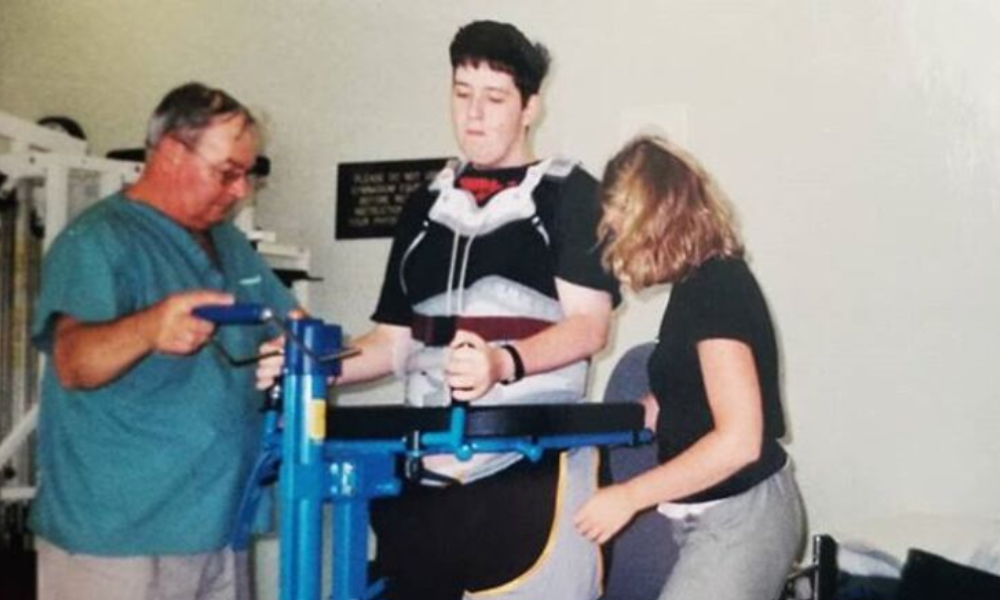The best welding helmets protect workers against potentially vision-damaging injuries. Take your pick from these top-notch products

Welding helmets are an essential part of a welder’s personal protective equipment. Without one, workers are exposed to vision-damaging sparks and radiation. This highlights the importance of wearing the right eye and face protection, especially for welders doing industrial work.
In this article, Canadian Occupational Safety reveals our picks for the best welding helmets for industrial use. We will dig deeper into each product’s features and specifications. We will also give you a rundown of the different factors to consider when choosing the right equipment.
If you’re looking for proper protection for your team, this guide can give you options. Take your pick from our list of the top welding helmets for heavy-duty use.
What are the best welding helmets for heavy-duty work?
Welding is an important part of several industries, including construction, automotive, manufacturing, and oil and gas. This makes it quite challenging to choose the appropriate eye and face protection for your team. To help you in your search, the COS research team scoured the market for the top welding equipment.
Here are our picks for the best welding helmets for industrial work, arranged alphabetically. All units integrate with powered air-purifying respirators (PAPR). Prices are current as of July 17, 2024.

1. 3M Speedglas G5-02 welding helmet
Viewing area: 150x76mm
Shade range: 8 to 12
Number of sensors: 3
Key features: Curved glass auto-darkening lens, sensitive arc detection, adjustable delay function
Price range: $1,159.95 to $1,350.00
The auto-darkening lens of 3M’s Speedglas G5-02 welding helmet uses curved glass technology. This allows welders to recognize colours easily. The equipment also features sensitive arc detection, making it an ideal protection for TIG welding.
The welding helmet enables Bluetooth connectivity and comes with an adjustable delay function to set dark-to-light opening time. Users can also select the right settings for each task through a mobile app to help reduce eye strain and improve vision quality.
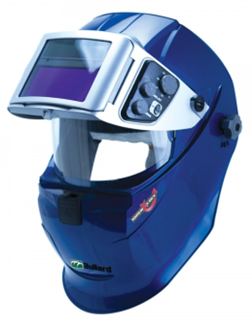
2. Bullard Sparxlift welding helmet
Viewing area: 97x46mm
Shade range: 9 to 13
Number of sensors: 2
Key features: UV and IR filters, patented AutoLift design, Inner Sense technology
Price: US$1,706.46
The Bullard Sparxlift welding helmet uses full-time ultraviolet (UV) and infrared (IR) filters to prevent flash in 1/25,000 second. The equipment’s clear panoramic polycarbonate lens comes with an auto-darkening filter while the engineered lightweight nylon shell withstands heat and impact.
The helmet features a patented AutoLift design that allows users to switch from welding to grinding at the push of a button. The welding equipment also integrates the patented Inner Sense technology that detects RF signals emitted from TIG welding. This enables the screen to automatically darken before the arc is struck.
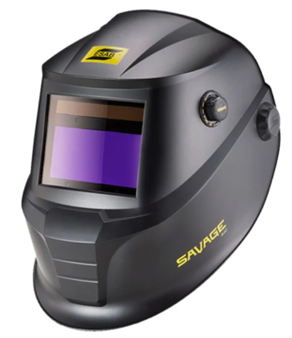
3. ESAB Savage A40 welding helmet
Viewing area: 100x50mm
Shade range: 9 to 13
Number of sensors: 4
Key features: Delay and sensitivity controls, True Color lens technology, four arc sensors
Price: $1,599.97
The Savage A40 model from ESAB is one of the best welding helmets for industrial tasks. It uses four arc sensors for better darkening response. Shade delay and sensitivity can be adjusted from inside the equipment. The delay control lets users set how long the lens stays dark after the welding arc stops. Sensitivity control allows better reaction to darker arc light.
The welding helmet uses the ultra-clear True Color lens technology for enhanced colour definition. It suits various processes, including oxyfuel cutting, plasma cutting, grinding, and MIG, MAG, and TIG welding.
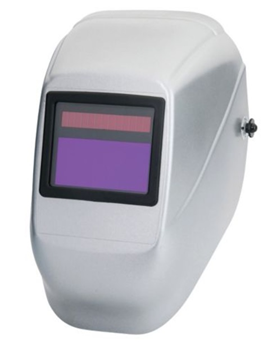
4. Honeywell Tigerhood Futura XXL welding helmet
Viewing area: 3.78x2.68in
Shade range: 9 to 13
Number of sensors: 2
Key features: ADC Plus ADF technology, user adjustable delay, constant UV/IR protection
Price range: $755.76 to $851.32
Honeywell’s Tigerhood Futura XXL welding helmet uses the brand’s ADC Plus ADF technology, its widest to date, providing 40% greater viewing area than previous models. The technology allows welders to see more clearly and work at awkward angles more easily. It also delivers uniform shading and distortion across the entire viewing area. User adjustable delay from dark to light is at 0.2 to 0.8 seconds. Switching speed is at 15ms at 73° F. The welding helmet provides constant UV and IR protection.
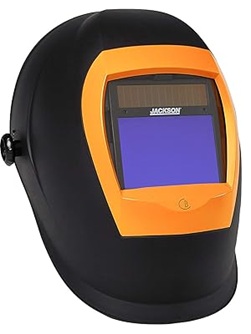
5. Jackson Safety BH3 welding helmet
Viewing area: 96x68.5mm
Shade range: 9 to 13
Number of sensors: 2
Key features: 1/1/1/1 optical clarity, Balder auto-darkening filter, three-point headgear adjustment
Price range: $427.99 to $526.04
The BH3 model from Jackson Safety has earned the highest rating for optical clarity at 1/1/1/1, making it one of the best welding helmets on the market. It also received the best classification for angular dependence. The equipment uses Balder’s auto-darkening filter, allowing welders to see clearly at different angles. The headgear can be adjusted at three points to suit various tasks.

6. Lincoln Electric Viking 3350 Series welding helmet
Viewing area: 95x85mm
Shade range: 5 to 13
Number of sensors: 4
Key features: 1/1/1/1 optical clarity, 4C Lens technology, convenient control for shade adjustment
Price range: $410.00 to $751.00
Lincoln Electric’s Viking 3350 Series welding helmet uses 4C Lens technology, which broadens the colour range visible in both light and dark states. The technology also eliminates colour imperfections and saturation to provide welders a clear view of the base material, arc, and puddle.
The equipment has earned a perfect 1/1/1/1 rating for optical clarity, making it one of the best welding helmets on the market. Users can also adjust between shades or switch to grind mode via the control dial at the left side of the headgear. No need to remove the helmet while working.
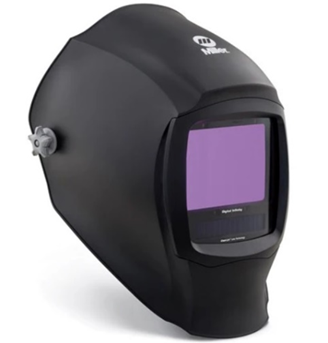
7. Miller Electric Digital Infinity Series welding helmet
Viewing area: 13.4 square inches
Shade range: 8 to 13
Number of sensors: 4
Key features: ClearLight 2.0 lens technology, AutoSense filter technology, InfoTrack 2.0 monitor
Price range: $492.00 to $736.00
The Digital Infinity Series welding helmet from Miller Electric uses ClearLight 2.0 lens technology for a clearer, more realistic view. The unit also features AutoSense filter technology that automatically sets sensitivity. This makes the welding helmet best for users who need to adjust their settings frequently for changing work environments.
The equipment also integrates InfoTrack 2.0 technology, which monitors arc time and arc count. It comes with digital controls and four operating modes: weld, grind, cut, and X-mode.
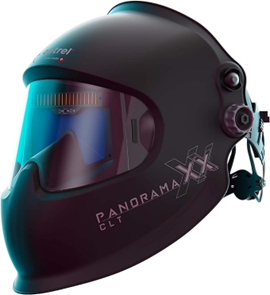
8. Optrel Panoramaxx CLT welding helmet
Viewing area: 8.74 square inches
Shade range: 8 to 12
Number of sensors: 5
Key features: ShadeTronic protection adjustment technology, five-sensor control, adjustable anti-glare display
Price range: $799.25 to $1,250.00
Optrel Panoramaxx CLT welding helmet provides users with an extended panoramic field of vision that automatically adjusts to changing light conditions of the welding arc. The unit comes with an intelligent five-sensor control to adjust shade levels even in the most challenging lighting conditions. The opening of the anti-glare display can be adjusted continuously after welding to help reduce eye fatigue.
The welding helmet is rated 1/1/1/2 for optical clarity and provides protection against UV and IR radiation.
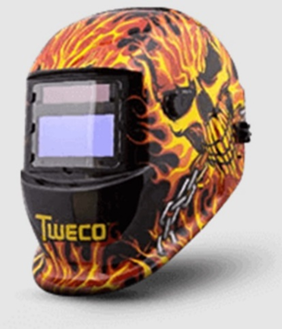
9. Tweco WeldSkill welding helmet
Viewing area: 98x43mm
Shade range: 9 to 13
Number of sensors: 4
Key features: Four arc sensors, three dark-to-light switching speeds, lightweight
Price range: $113.32 to $224.77
The Tweco WeldSkill welding helmet uses four sensors for better auto-darkening function. The unit can be used in weld and grind modes and darkens when TIG welding even at 5 amps. When switching from light-to-dark, the equipment darkens in 33 microseconds.
Users can select from three switching speeds – short (0.25s to 0.35s), medium (0.35s to 0.50s), and long (0.50s to 0.80s) – when switching from dark to light. The welding helmet weighs just 16oz.
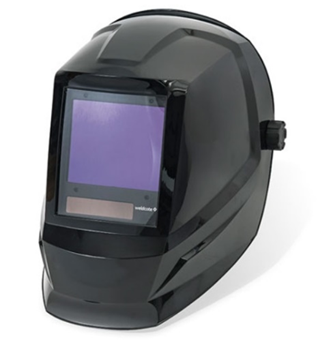
10. Weldcote Metals Ultraview welding helmet
Viewing area: 3.94x3.28 inches
Shade range: 9 to 13
Number of sensors: 4
Key features: True Color lens technology, four arc sensors, permanent UV/IR protection up to DIN 15
Price range: US$125.99 to US$167.99
The Ultraview welding helmet has a large viewing area that uses True Color lens technology for a clear and natural view of the weld area and arc. It also has four independent sensors that deliver quick reaction times. This allows the unit to adjust automatically to the arc’s brightness, making it suitable for various welding processes, including stick, MIG, and TIG. One of the best welding helmets in the market, Ultraview provides permanent UV and IR protection. It features a nylon shell that withstands high impact.
Find out which type of eye and face protection suits your welding operations in this essential guide to personal safety equipment in Canada. This guide includes downloadable checklists of the PPE requirements for each industry.
Does a good welding helmet make a difference?
There are several risks associated with welding. The biggest of these are harmful gases and fumes that can damage the respiratory system. Welding can also cause serious injuries to the eyes and face.
The ultraviolet and infrared radiation emitted from the welding arc can lead to a painful condition called arc eye, wherein the cornea becomes inflamed. Another potential hazard is retina burns that can cause loss of vision due to the concentrated UV and IR rays emitted during welding. Without the proper protection, sparks, spatter, and the intense heat from welding can result in facial burns.
Wearing a good welding helmet can make a huge difference in keeping workers protected against potentially vision-damaging dangers. If you’re looking for respirators to go with welding helmets for maximum protection, check out this guide to the best welding respirators for industrial tasks.
Is an auto-darkening welding helmet worth it?
Auto-darkening lenses are worth the investment for professional welders who do heavy-duty welding throughout the day.
As the name suggests, auto-darkening helmets feature lenses that are designed to darken automatically when the sensors recognize a welding arc. These helmets adjust shade levels based on the intensity of the arc. This function also eliminates the need to lift and lower the lens shade repeatedly for workers who do a lot of tack welding and short welds.
Those who go for passive lens welding helmets don’t have this luxury. While cheaper than auto-darkening versions, passive lenses don’t adjust to the intensity of the welding arc. These welding helmets also need to be lifted and lowered every time a new weld is started. Passive lens helmets are more suitable for occasional hobbyists and specific welding tasks.
How do you choose the best welding helmet for your team?
If you’re searching for a welding helmet best suited for industrial tasks, your best option is to go with auto-darkening helmets. Here are the different factors you need to consider when choosing one:
Viewing area
A large viewing area offers greater visibility, allowing welders to see more of the base material, arc, and puddle without moving their heads. It also helps improve accuracy and reduce neck strain.
Shade range
The wider the shade range, the better suited the helmet is for different welding processes. The best welding helmets have shade levels ranging from 9 to 13. Also look for versions that come with a grind mode feature. This type of welding helmet provides a lighter shade for non-welding tasks.
Lens reaction time
The rate at which the lens darkens when exposed to the welding arc is another important factor to consider. Choose helmets with a lens reaction time of 1/25,000 or quicker. The faster the lens responds to the arc, the better protection a welder gets against intense light.
Adjustable sensitivity and delay controls
Sensitivity controls enable users to adjust the welding helmet's reaction to different arc intensities. This is useful for those working in different lighting conditions.
Delay controls allow welders to modify the time it takes for the lens to return to its light state after welding. This feature makes doing longer tasks more comfortable by preventing the lens from flickering.
Comfort and fit
Welding helmets are designed to be worn for extended periods, that’s why comfort and fit are important. The headgear must be adjustable and have sufficient padding. It also helps if the shell is made of lightweight materials.
Safety standards
All welding helmets used in Canada worksites must comply with CSA Z94.3 standards. Other relevant safety certifications include the US’ ANSI Z87.1.
You may also have to consider the cost and maintenance of the welding helmets. Picking the right eye and face protection enhances safety and productivity within your team, so consider that a worthy investment. After all, choosing the best welding helmet means putting your workers’ health and safety first.
Visit our Product Resources page for more news and information about eye and face protection equipment and regulations in Canada.
What’s your pick for the best welding helmets for heavy-duty work? Let us know in the comments.
Related Articles:
The best safety glasses for construction workers
The most comfortable work boots for construction sites
The best hard hats to recommend to your construction team
The best work gloves for heavy-duty protection
The best hearing protection for construction workers
Roof safety equipment: an essential guide for roofers in Canada
The best ear protection for loud machinery
The 10 best respirators for painting projects
The best welding respirators for heavy-duty tasks


